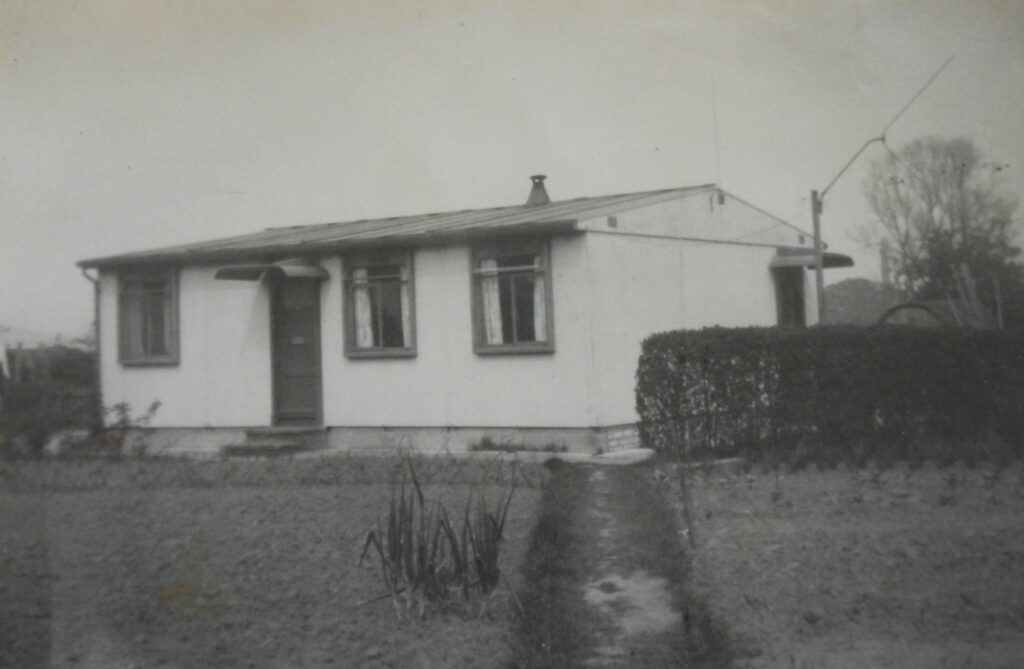
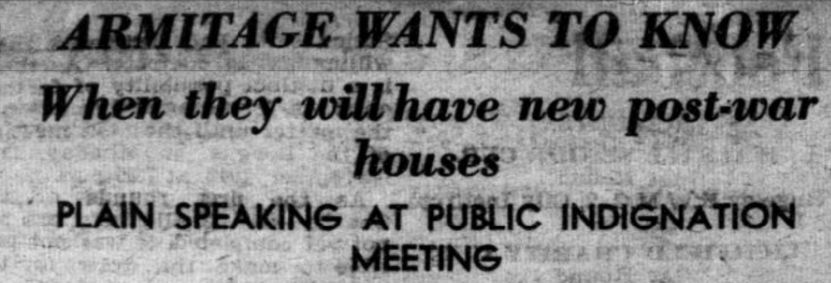
In October 1946 the Housing Committee of Armitage-with-Handsacre Parish Council convened a public meeting to ‘discuss the unsatisfactory progress of the new houses’. Held in the Parish Hall, crowded with many young married couples including young babies, the meeting was at times quite tempestuous. The Council Chairman, H. Wright, told the meeting about the unsatisfactory housing position and cited instances of eleven people in one house. One parishioner who lived with her husband and five children in two small rooms at Old Road told a story which revealed the seriousness of the problem. The wife of an ex-soldier, who now worked down the pit, said the family were forced to live in most unsanitary conditions, there being only one lavatory in use for three families.
Much to the exasperation of most councillors, Councillor Frank Hill continually made volatile statements stating that the people of the village were treated as cattle and not human beings. At one point he proposed “That this public meeting of parishioners, representing Armitage and Handsacre, view with concern the present and past administration of public services. The indifference to the lawful right of the public – particularly the wage earners – has created standing memorials indicating the misery of the helpless class. Failure to implement the powers which Parliament gave all Councils has resulted in high rents, insanitary conditions and terrorism”. No one present though was willing to second the proposal.
John Johnson stated that the proposal was too drastic and proposed instead that they should enquire three things of Lichfield Rural District Council (LRDC):-
- Who’s going to have the new houses?
- Who’s going to have the say as to who’s going to have them?
- What is the rent going to be?
This proposal was carried unanimously.
Scenes like these were repeated up and down the country as there had been no home building for many years because of the war and there were still great shortages of building materials. Armitage and Handsacre were no different to anywhere else in the country.
The short-term solution was to erect pre-fabricated buildings and the Government had been looking at the options since 1942 when the Burt Committee had been set up to ‘consider materials and methods of construction suitable for the building of houses and flats, having regard to efficiency, economy and speed of erection’. This had led to the Housing (Temporary Accommodation) Act of 1944 and the Emergency Factory-Made Housing Programme, known as the Temporary Housing Programme. The Act authorised the Government to spend up to £150m on temporary housing and a wide range of buildings were proposed. Most of these were of the bungalow type.
In July 1945 the housing committee of LRDC had recommended that 40 temporary pre-fabricated houses (pre-fabs) should be erected in Armitage. After the LRDC had received their full allocation of 100 pre-fabs in October 1945 there were only 30 available for Armitage. Most of Lichfield’s pre-fabs were to be of the Uni-Seco type i.e. built of wood and asbestos but those for Armitage were all to be built from aluminium. These were probably the AIROH type designed by Morrison Engineering Company. AIROH stands for Aircraft Industries Research Organisation for Housing and brought together several aircraft manufacturers to diversify their product lines in the immediate post-war period.
The bungalows were the gas type with the refrigerators powered by gas rather than electricity. The Lichfield Mercury thought they had all the ‘mod cons’ and gave a very detailed description stating that they had been designed for a family of four with a living room, two bedrooms, kitchen, bathroom and an outside shed. The kitchen had a refrigerator fitted under the draining board, with hot and cold water supply to the sink, and hot water supply to the washing boiler which had a flap work-top and compartment for the wringer hinged to lie flat when not in use. There was a cooker with a plate rack over it and cupboard shelving (and dish cloth rail!). The bathroom had a lavatory basin and bath with hot and cold water, a heated towel rail, and a light over the basin with a cupboard under it. The living room had utility cupboards and shelves with drawers whilst the bedrooms had wardrobes, linen cupboards (with shelves) and an extra shelved cupboard.
In October 1945 the LRDC resolved that power conferred by the 1944 Act should be exercised in obtaining just under 6 acres of land off Rugeley Road more or less opposite the Parish Hall in Armitage. Gladys Phillips of Penn, Wolverhampton, eventually sold the land to the council for £880. By March 1946 the layout plan had been submitted and LRDC had agreed to pay the gas Company 1/- per week per house for the supply of gas to the refrigerator (which would be added to the rent).
The land was handed over to the Ministry of Housing whose duty it was to erect the pre-fabs and German POWs were drafted in to clear the site as well as what was known at the time as the Chapel Street site, opposite. Six months later though and there had been no further progress, hence the calling of the public meeting by the Parish Council Housing Committee. Just a week before the meeting though Thomas Lowe & Sons who would be erecting the prefabs had turned up and erected their office on site preparatory to the actual work.
Following the public meeting the housing committee submitted their list of names for tenancy of the pre-fabs as can be seen from the minutes of their meeting held on Monday 23rd December 1946.
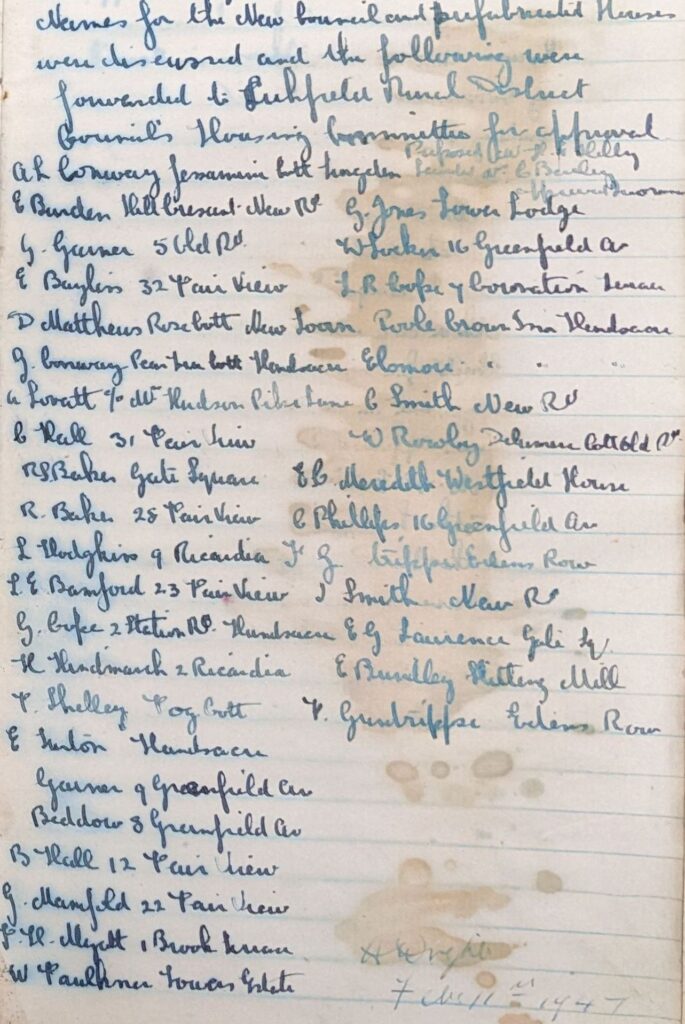
From the names submitted for the 30 pre-fabs, 27 were to become tenants in The Avenue as the site was first called – LRDC later renamed it Upper Lodge Road. By May 1947 the pre-fabs were up and occupied. The prefabs, made of aluminium, were white which made them excellent in the summer but absolutely freezing in the winter. Residents remember water freezing in glasses and on the inside of the windows and coats being used on top of blankets in an attempt to keep warm.
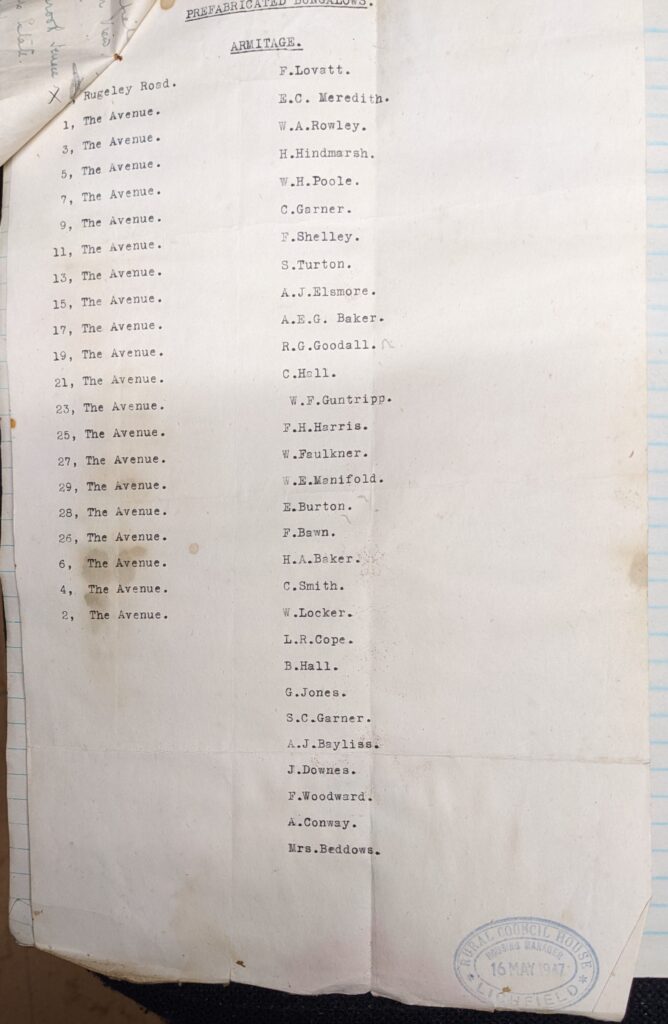
Coal was still rationed and the Parish Councillors often received complaints about the quality of the coal as well as the quantity. Another frequent complaint was about meat and the Parish Council wrote to the local MP, Julian Snow, a number of times in an attempt to get an improvement.
The Rugeley Times on 9th October 1948 reported on an LRDC discussion on the subject of greenhouses and poultry houses etc for the aluminium style pre-fabs:
The Housing Manager reported to the Rural District Council regarding numerous requests received for permissions to erect greenhouses, poultry houses etc., observing that in the past it had been the rule to prohibit any such erections.
A member stated that today when pigs were almost a rarity and luxury applications by people who wanted to erect sheds should be given serious consideration if the sheds were in accordance with the by-laws and were not an eyesore and given the sanction of the Surveyor if such places were not a nuisance, especially in rural areas.
Councillor Ashley said many people were living in these pre-fabricated houses not by choice and many of them had hobbies which occupied their time after leaving work. He considered the Council ought to give permission so that tenants could raise a few tomatoes and have a few fowls and have the opportunity of keeping a pig. If the Surveyor considered such sheds etc conformed to what the Council considered was reasonable they ought to give support. The Vice-Chairman, (Councillor E.V. Smith) said that at the committee meeting every consideration was given for the people to keep poultry, pigs etc. The matter was referred to a sub-committee for consideration and report.
By the time of the next monthly Council meeting a letter had been received from the Land Settlement Association Ltd., (LSA), requesting that the Council consider buying plots of land adjacent to existing housing estates upon which tenants could provide for domestic food production by the keeping of livestock or vegetable gardening – the tenancy of such land and the administration thereof to be under the jurisdiction of the LSA on behalf of the Council. The LSA was a Government scheme originally set up in 1934 to re-settle unemployed workers from depressed industrial areas on smallholdings. The LSA wanted to demonstrate that their system would work equally well with housing estates as with smallholdings.
The Council resolved that as an experiment the Housing Manager should investigate the demand for such activities from tenants of the Armitage pre-fab estate. Tenants of the pre-fabs were in favour and before long the Council had bought an acre of land next door. The LSA quickly installed a demonstration stock allotment unit consisting of six poultry holdings and a range of six pigsties having proper facilities for drainage and storage of manure. The runs had been levelled and grassed and were strongly netted and the poultry runs each had an ark so that tenants could rear their own growers to replace year-old layers. Each pigsty had a grass paddock area to complement the concrete stye area and yard. There was also a boiler house containing a steam pressure boiler for boiling swill. The Armitage Stock Allotment Scheme was up and running with Jack Whitehouse as Chairman and Sid Turton as Secretary (although the newspapers had his name as Turlow). The Staffordshire Farm Institute had a department devoted to small live stock and they also provided support.
The allotments attracted a lot of visits from the Ministry of Agriculture, the Ministry of Town and Country Planning and the Staffordshire County Council. The LSA also heavily promoted the scheme with visitors from London, Peterborough, Coventry and Walsall all visiting the site in its first six months. The Staffordshire Advertiser edition of 12th October 1951 was able to announce that the site was to be televised.
Despite this promising start the scheme lasted less than 10 years and in March 1958 the ‘prefabricated sectional concrete piggeries at Bardy Lane, Armitage’ were offered for sale, as standing on site with the purchaser to remove them. Particularly during the winter months the work looking after the stock fell on the housewives as the men were out at work but it may well have been the practicalities of dealing with the meat that caused the biggest problem. Quite a few of the local population kept pigs and a local butcher would come along and kill the pig taking a cut of meat for his trouble and the householder often then hanging the pig up for bacon etc. A dead pig though takes up a lot of room and before the advent of big home chest freezers the pre-fabs would simply not have had the room to hang the pig.
The next big housing development in the village was Millmoor Avenue in 1955 and although the design life of the pre-fabs was only 10 years there were other people in need of houses so the tenants of the pre-fabs had to stay put. In 1962 LRDC submitted a plan for ‘aged persons dwellings’ -10 one-bedroomed bungalows with a two-bedroomed flat for a warden at Bardy Lane next door to the pre-fabs. A further 3 two-bedroomed bungalows were added to the scheme with the plan that the scheme could be extended in the future when the pre-fab site was redeveloped.
The pre-fabs were to last nearly 20 years and the story ends with another angry meeting as detailed in the Rugeley Times, 29th October 1965.

Armitage’s pre-fab folk, angry at the allocation of new homes, quizzed a council’s housing chief at a meeting on Tuesday.
Lichfield Rural Council is replacing 30 pre-fabs built at Upper Lodge Road in 1947. The first phase of the scheme, now completed, was to build 14 homes on an adjacent site.
Occupiers of the top 14 pre-fabs in the road moved in, enabling demolition work to start. When the site is cleared another 16 homes will be built and the remaining pre-fab folk housed there.
The remaining pre-fabs can then be demolished and the contractors can complete the project which is for a total of 69 new homes.
The homes so far built are four three-bedroomed houses, five two-bedroom bungalows, and five one-bedroom bungalows.
Frustration
But not all the pre-fab folk are happy with the new homes. Said Parish Council chairman Mr. B. Till on Tuesday: “It may be that they feel some frustration at certain developments that are taking place.”
The council’s housing manager, Mr. R. E. C. Long, faced a barrage of questions.
Mr. Harold Hindmarsh asked: “Why have they decided to build flats at all at Upper Lodge? Quite a few people do not particularly want flats. I do not think it is fair that, after waiting in some cases 19 years, they should be pushed into flats. I do not think that they are getting a fair crack of the whip.”
Mr. Long:” Generally speaking, with land costing what it does today, the council feels that it has to make the best use of land at all times.”
One woman said she did not consider a flat suitable for her and her family. Mr. Long said that the council would try to find a suitable house”.
Mr. Joe Simpson said that it appeared that one or two people were jumping the queue to be rehoused. He wanted to know how it was decided who had prior claims for a new home.
Confidential
Mr. Long replied that a letting sub-committee made the allocations and that all information given to the sub-committee was confidential. He pointed out that often factors were considered which neighbours did not even know about.
Asked if the council would effect repairs to pre-fabs while the occupiers were waiting to be rehoused, Mr. Long pledged: “We would do whatever was possible to make life as happy as possible in the interim”.
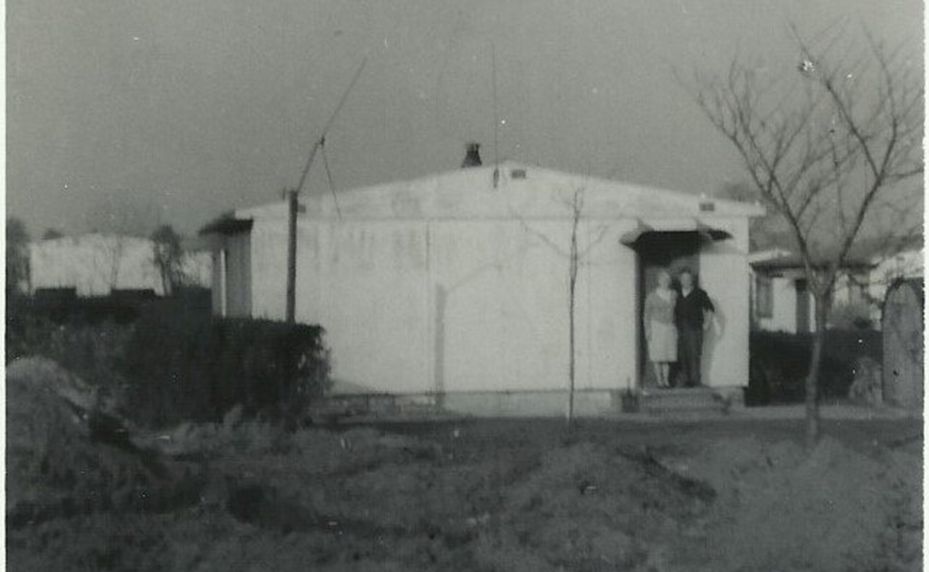

Richard, another good article. You’ve written that Millmoor Avenue was the next major development but the houses in Tuppenhurst Lane and Croft Leys were built earlier in the 50s when we were amongst the earliest residents, having moved from Armitage. I’m not including the much larger coal board development built across and down the road in the 60s.
So interesting to be made aware of such practical community awareness of need and what to do about it.